
From Mobygames.
We’ve so far seen two games by Dale Johnson, Mad Venture (with Christine Johnson) and Palace in Thunderland (with Ken Rose). In Mad Venture there was an item that mentioned Palace, and in Palace there was an item that mentioned Mystery in Madness, Dale Johnson’s third game.
>READ BOOK
IT READS, “LOOK FOR THE NEXT ATTRACTION, MYSTERY IN MADNESS” AT YOUR LOCAL COMPUTER STORES SOON!”
The game never was finished as Mystery in Madness, but there was a 1982 version called Mission in Madness.

This was followed by another 1982 version called Madsquerade, which added what I might call “programmer art” to the game.

From A2Can’s Twitter feed.
Neither of these versions are that famous, and in fact I have no access to the early graphical version. What I do have access to is the version from 1983 called Masquerade (eventually dropping the “mad” bit altogether) as published by Phoenix Software. It includes new art by a name that might be familiar.
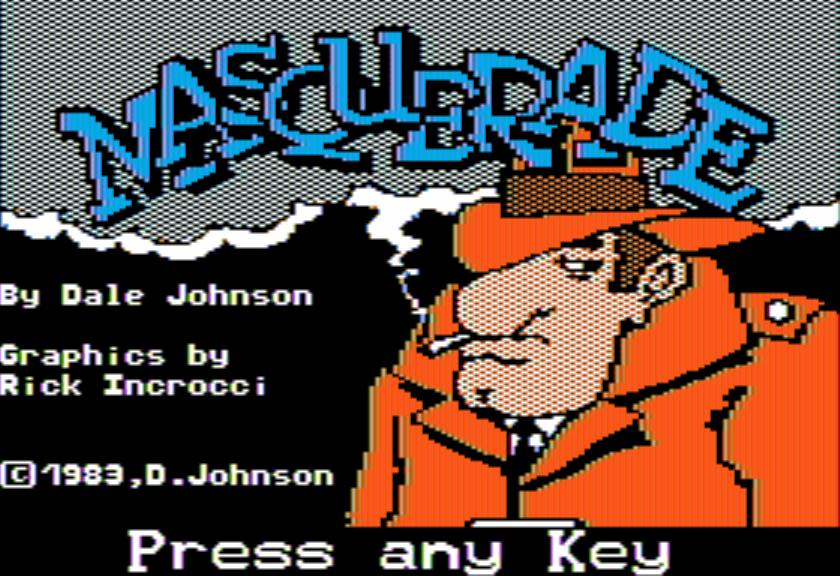
Yes, that’s the same Rick Incrocci who did Lucifer’s Realm.
Back in ’82 I bought my first Texas Instrument Computer – then an Apple II. I fell in love with computers and things just started happening. I had been a cartoon illustrator for many years prior – so making the move to computer graphics was no big deal (I bought two very expensive graphics tablets that Apple used to make – back then, they were about $800 each). I was doing computer graphics for a few Chicagoland educational houses – then places like Phoenix and Penguin Software just started calling me out of the blue. It was a small world back then – just a few computer artists in Chicagoland and a lot of small software companies that actually worked out of their homes. Not any more.
— Quoting Incrocci from the Gallery of Undiscovered Entities
I wish could explain exactly the history sequence here, but it is still a little mysterious. Dale Johnson died in 1999 so nobody can ask him. I especially don’t know where or how the earlier two versions surfaced — were they published? I haven’t found any ads indicating such, and Mad Venture and Palace in Thunderland had both fairly prominent spreads. Maybe they were just given out at the Northern Illinois Apple Users Group, or even shown off without distribution? Everyone in the Chicago area knew each other, so at least it isn’t shocking that Madsquerade landed into the hands of Phoenix for publishing.
I’m going to play the Incrocci version but I may refer back to the text game sometimes, especially if the puzzles start to get gnarly; perhaps there will be a different description or puzzle sequence that will help decipher what’s going on in the 1983 version of the game.
By “everyone seems to know”, there later was a French version called Marmelade, which is the sort of thing that can only happen if your game gets widespread; additionally, it made the charts at Softalk. Still, the Gallery of Undiscovered Entities, who got their numbers from Ron Unrath, founder of Phoenix Software, gives an estimate of 1500 copies sold. 1500 is not huge even for that era, but I suspect widespread piracy; Paul Berker (of the prior Phoenix games Birth of the Phoenix and Adventure in Time) mentions at “pirate parties” most people he bumped into at Apple II meetings knew about his games but hadn’t bought them.
Masquerade has our hero a detective on the hunt for the crime lord Mr. Topp. In both of the early versions the intro reads:
YOU’VE BEEN TRACKING A NOTORIOUS HIT MAN FOR WEEKS. YOUR MISSION IS TO FIND THE “TOP MAN” IN THE ORGANIZATION AND DO AWAY WITH CRIME!
For the 1983 version:
YOU’VE BEEN TRACKING A NOTORIOUS HIT MAN FOR WEEKS. YOU TRAIL HIM TO A SEEDY HOTEL ROOM, BREAK IN, AND WITH THE BUTT END OF YOUR TRUSTY .44 MAGNUM, KNOCK HIM COLD. THIS COULD BE THE LEAD YOU’VE BEEN WAITING FOR.
This makes it a little clearer what’s going on at the start:

That is, we weren’t hanging out in a hotel room and got ambushed; we did the ambushing. Searching the body reveals a wallet with one (1) dollar and a business card.
Ivan Tupickemoff — Professional Assassin — Hours by Appointment
Plot-wise I’d think we’d want the assassin awake for interrogation, but maybe things went a bit wrong. Perhaps we need to wake him up as part of the game (there’s a tricky aspect to that you’ll see in a moment).
Moving the body reveals a key (note: SEARCH and MOVE revealed different things — this also is probably a game where you need to SEARCH multiple times). The key unlocks the briefcase which has a mask and mysterious box that gives a high-pitched squealing sound; I have yet to find a use for the latter.

Just outside the hotel room is a phone booth with a bomb. The bomb is set to explode at 6:15 exactly. In addition to the gun we start with a watch indicating that’s about an hour away.
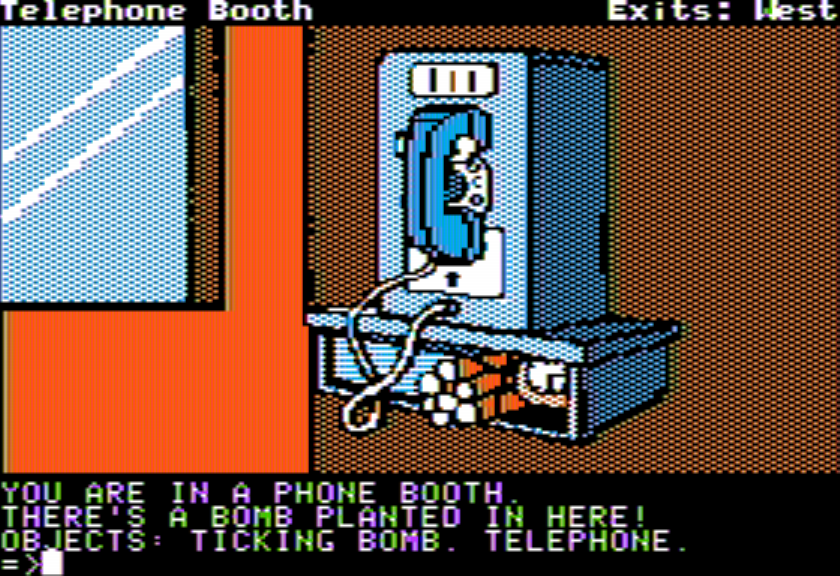
Just as a test, I went outside the hotel and waited, and you can indeed witness demolition followed by rubble. Since no items seem to result, this seems to be more of a general time limit we have to worry about than a return-later style puzzle.



Before moving on to town, I want to mention one difference in the text-only version of the game. There’s a meta-conversation where there’s a room in the hotel with an adventurer.
YOU ARE IN A PRIVATE HOTEL ROOM
EXITS: EAST
OBJECTS: ADVENTURER. APPLE.
>LOOK ADVENTURER
HE IS EXHAUSTED. HE MUTTERS, “AT LAST I FOUND THE TOP MAN, BUT, AS USUAL, GOT KILLED. LET’S SEE, THAT’S ABOUT 17 DIFFERENT WAYS I MANAGED TO KILL MYSELF. (GASP, COUGH!) THE PUZZLES SEEMED SO EASY AT FIRST, BUT THEN I REALIZED THAT THERE WERE MULTIPLE SOLUTIONS AND ONLY ONE IS RIGHT. BUT WHICH ONE…”
This is explicitly discussing up front one of the game’s patterns, which is that you can solve puzzles in a “wrong way” using up an item that’s needed for later. I know one bit where I’ve likely already hit this. I’ve never seen the “main text” of a game — as opposed to hints from the game’s manual — explicitly call out one of the gameplay patterns early like this.
(Aside: is there a better term than “gameplay patterns” here? That’s all I’ve been using in the past but I’d love a term that implies “things that aren’t true about all text adventures generally, but just about some games in particular, and they can take some work on the player’s part to extract out and might even be subconscious tendencies of the author they aren’t aware of”.)
Moving on past the hotel room to the main town, there’s not any explicit investigating going on: rather, you are being followed.

The “mysterious figure” who is watching you shows up in the graphical game in the lower left corner as a shadow. Once the figure is following it has a random chance of throwing a knife and killing you outright like one of the dwarves from Crowther/Woods Adventure. You might think to use your gun to just shoot the person, but alas, your gun has no bullets.
There is a way to forestall the figure appearing for a while: wear the mask. The figure normally appears immediately upon leaving the hotel area, but the appearance is delayed at least slightly if you’ve got the mask on.
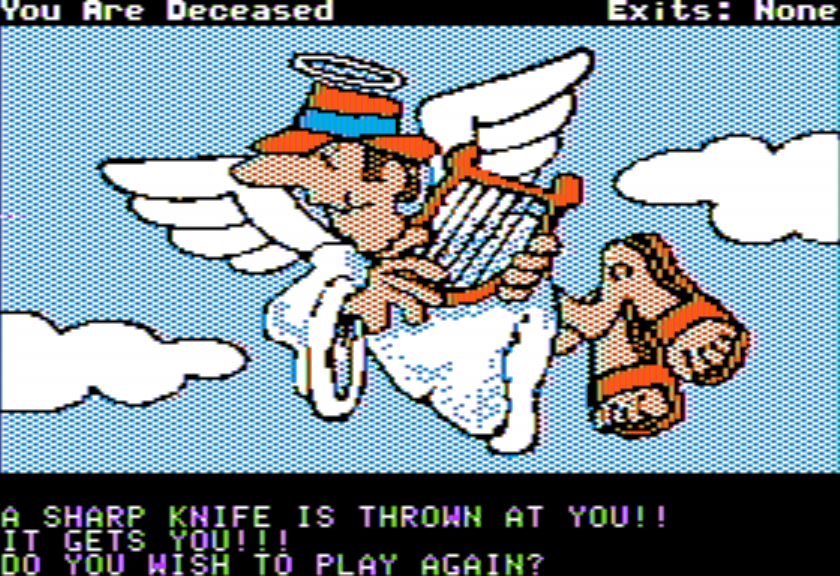
Here’s the map of the town I have so far:

Due to knives it took a couple passes through to see everything. There’s a movie theater early that wants $5 for entry (only a dollar to start from the assassin’s wallet, alas) and there’s a zoo that wants $1 for entry.


While paying the $1 works for the Zoo, there’s a popcorn seller immediately inside who wants $1, so I suspect you might get in the Zoo via a different route and save the dollar for popcorn.

Other scenes in the zoo: a fence that’s electrified and will kill you if you climb it, a building with security that will kill you if you try to go in, and a snake by a rock that will kill you if you pick up the rock.
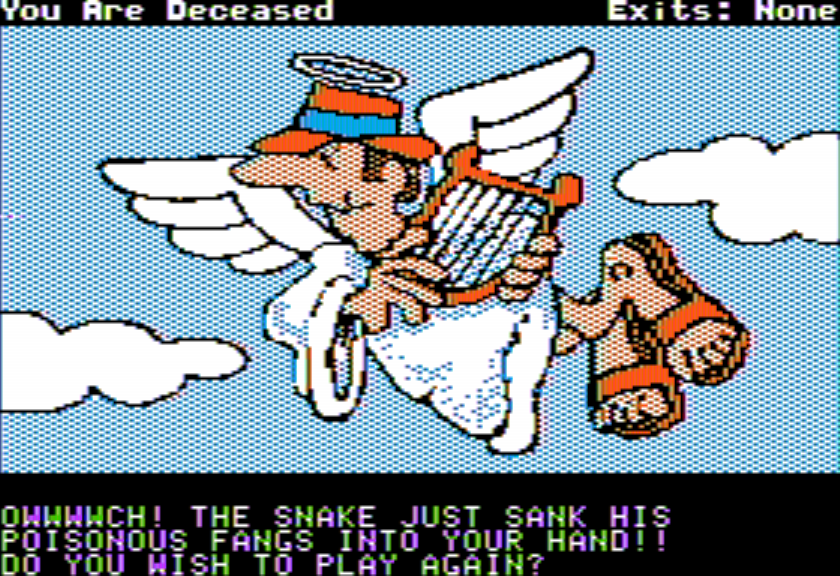
Another part of the zoo has a bird, but if you try to take the bird and throw it at the snake (copying the Original Adventure solution) it just flies away.

Finally there’s a “beggar” and a “monkey house” I’ve done nothing yet with.
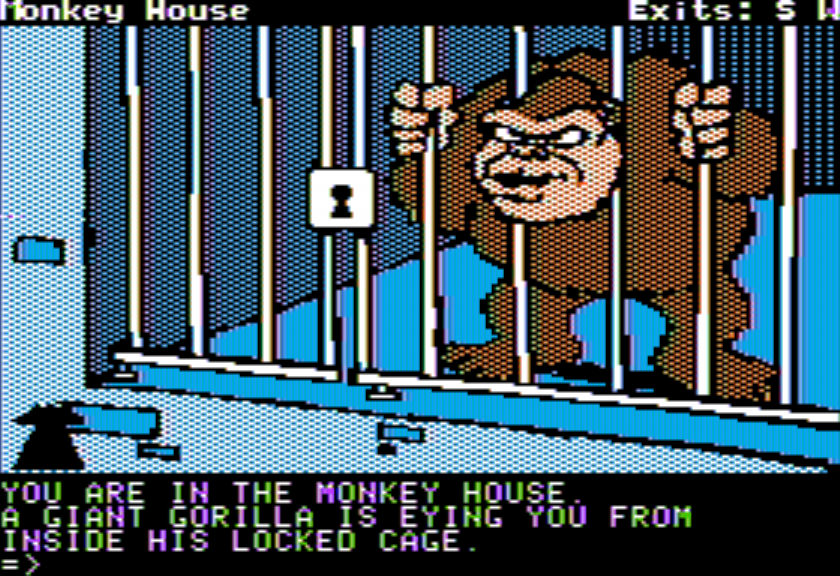
This one’s going to be tricky, I’m sure. I’m not just basing this on the previous Dale Johnson games (Alice in Thunderland was delightful but absolutely personified tough-as-nails puzzlebox) but the fact there was a contest with $1000 for a solution to the game, invoking the same shenanigans as various UK companies. The contest was eventually won and paid out but after Phoenix already got sold to another company (American Eagle) for reasons I’ll save for another time.
I am marveling at Incrocci’s artwork and can’t help but compare it to the amateurish artwork from (much bigger) contemporaries like Sierra. I wonder why they never hired him? His worth with color dithering also was just remarkable. Look at how orange dithered with black looks brown but orange dithered with white looks beige. That illusion went incredibly far in convincing me as a child that the Apple could display a lot more than 4 (6 including black and white) colors. When my family moved on to a 286 PC in 1986 and I experienced CGA’s awful cyan/magenta color palette for the first time, I felt like we had stepped backwards technologically.
I mean, Ken hired someone he met while food shopping. Their main artist on Time Zone was a teenager who kind of melted down from the workload
>John Williams remembers the poor kid “almost in tears” from the stress, but still frantically sketching away.
so I think professionalism was still getting sorted out in ’81.
Interesting re: the artist. Years ago I when I was on an Apple ][ emulation tear, I downloaded the .dsk file for Sherwood Forest from the Asimov archive and all of the versions were corrupt. Did you find a working one, or do you not tackle these tasks in advance of publishing?
there’s a 4am version from last year that works fine
https://archive.org/details/SherwoodForest4amCrack
also had the artist’s name wrong, it is Dav Holle
Just downloaded. Works great– thanks! Interesting how I always associated this art style with Incrocci’s. I imagine there had to have been cross-inspiration considering how small the game publishing world was, and both games were published by Phoenix. (Sherwood’s box art indicates it is a “class 3” adventure whereas Masquerade is “class 5”). Also, I’m sure when it’s time for Sherwood Forest you’ll delve into whether there were any more “Sof-Toons”. I don’t recall there being any.
The CGA Cyan/Magenta/White palette is a weird historical curiosity. The first generation of CGA cards could produce a composite NTSC signal and be hooked directly to a television (Well, sorta; normal TVs of the period didn’t have composite inputs, but there were RF modulators available). Cycling patterns of cyan, magenta and white quickly enough in certain combinations, when converted into an NTSC television signal, would produce color artifacts that let you effectively get 16 colors instead of 4, and the 16 you end up getting is a pretty decent balanced palette with a nice range of reds, greens and blues. (The other CGA palette, red/yellow/green produces a different set of 16 that I’d characterize as being more earth-tones)
Many moons ago I worked for Reuters in London as an installation engineer and my least favourite job was setting up slave monitors via one desktop pc when the clients were too mean to pay for another one. This used to consist of endless chains of Way Converters and RGB leads together with several T-pieces to connect them all together. I would say that eight times out of ten as a guestimate there would be no signal at all to the distant slave monitor, or if I was lucky a flickering screen or horrible shades of the three primary colours melding together.. Changing the refresh rates made little or no difference on the early CRT monitors. I always seemed to get these jobs on a Friday afternoon and finish late. Mercifully Amulet (where the signals are transmitted via Cat 5 cables) came in around 1999 and saved a lot of hours and grief.
Although even worse was the job shinning up ladders onto the roof of a City of London building to fit a Reuters plastic owl (yup there was a part number for it) near the satellite dish to dissuade birds from perching on the LNB.
> His worth with color dithering also was just remarkable.
Those dither patterns were characteristic of the graphics tools by Penguin Software (the Complete Graphics System and then Graphics Magician). These revolutionized Apple game art, and were used for lots of 1982-ish Apple games.
(See credits listing mentioned at https://bluerenga.blog/2021/10/11/the-institute-1981/ , for example.)
That makes a lot of sense. It also explains why Sierra wasn’t using another company’s software to make their games. Sierra’s amateurish stick figure-and-indistinguishable blobs artwork always looked to me like it was coded, plotted using code, rather than drawn on a Koala pad or other tablet device with a graphics package, which is how the Incrocci artwork looks. The quality of the drawing in Sierra’s “The Dark Crystal” does look better than usual, but still doesn’t hold a candle to games like Masquerade.
I’m assuming Sherwood Forest was also an Incrocci game? Is that one coming soon?
On my big list of random, Sherwood Forest actually came up next. But with some research I realized this game had to have been written first (even if it got published after) so I swapped the order. Sherwood is (probably) early 2024.
Dav Holle did the art though, different Chicago person.
I wonder if Tom Selleck claimed royalties? If so he could have used the rhino to pay for some acting lessons.
Regarding the cover art, there’s a very old game from the mid 80s (analog, not computer game) called Gumshoe with a staggeringly similar cover, down to the celebrity knockoff. Gumshoe was published in 1986, several years after Masquerade, so if any plagiarism was going on it was from Gumshoe.
https://boardgamegeek.com/boardgame/3365/gumshoe
The cover art has always given me an Inspector Clouseau vibe, if anything.
Facially I’d definitely say Selleck. Sartorially Sellers perhaps.
Masqueraaaaaade! Paper faces on parade.
Mas-querade. Hide your face, so the world will never find you!
Who let Andrew Lloyd Webber in here?
Not forgetting the late great Leon Russell’s Carpenter recorded song. And definitely forgetting Richard Jobson jumping around in front of Stuart Adamson on Top of the Pops.